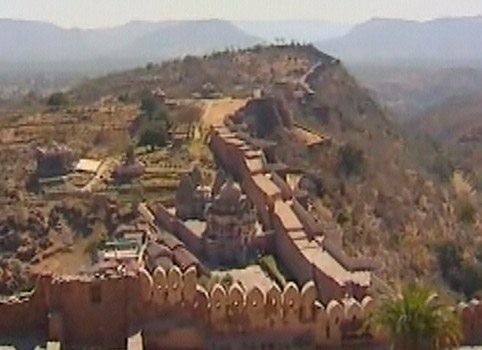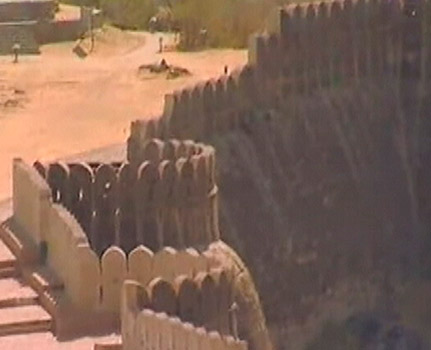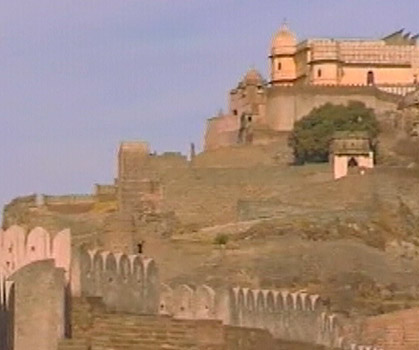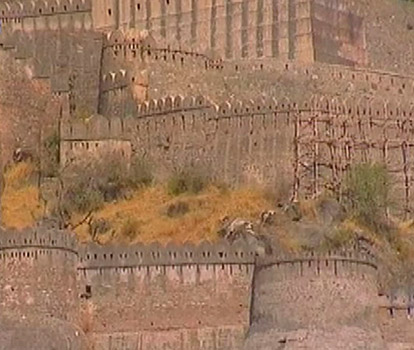 |
|
|
 |
|
|
| Home | Rana Kumbha | Kumbha Palace | Badal Mahal |
| Shiva Temple | Pitalia Dev Temple | 52 Chatries Jain Temple | Golesh Jain Mandir |
| Hotels at Kumbhalgarh | Maharana Pratap |
 |
 |
| History
Of Kumbhalgarh
Under the rule of the king Rana Kumbha, the kingdom of Mewar stretched right from Ranthambore to Gwalior. The kingdom also included vast tracts of Madhya Pradesh as well as Rajasthan. About 84 fortresses have been defending Mewar from its enemies. Out of the 84, Rana Kumbha, himself, has designed about 32 of them. Of all the fortresses, which have been designed by Rana Kumbha, Kumbhalgarh has been the most impressive, famous and the massive one with a wall of the length 36Km. The fort lies at about 90Kms away from Udaipur towards its Northwest. It is situated at about 1914m above the sea level and is the most important fort after Chittorgarh. The site where Kumbhalgarh stands once was a bastion, which belonged to the Jain descendent of Mauryan emperors of India during the second century AD. It also separated Mewar and Marwar from each other and was also use as a place of refuge for the rulers of Mewar at times of danger, especially Prince Udai, the baby king of Mewar. It was only once in the entire history that Kumbhalgarh was taken or it could not defend or breach its defense when the combined armies of Emperor Akbar, Raja Udai Singh of Amber along with the armies of Raja Man Singh of Amber and Raja Udai Singh of Marwar attacked the fort of Kumbhalgarh. That too happened because of the scarcity of drinking water. Kumbhalgarh is the same place where prince Udai was smuggled to in 1535. This happened when Chittaur was under siege. Prince Udai who later became the successor to the throne also became the founder of the Udaipur City. The renowned Maharana Pratap, who fought against the army lead by Akbar in the battle of Haldighati in the year 1576, was also born at Kumbhalgarh. Rana Kumbha who found the fort of Kumbhalgarh got it constructed in the 15th Century. Kumbhalgarh Fort was one of the very few forts in history, which never got conquered. One of the most important reasons stated for it is the aggressive or the hostile landscape of the fort. A thick wall that is 36Kms long surrounds this remarkable fort. The perimeter of the wall is assumed to be the longest after the Great Wall Of China. The wall stretches across the Aravali Mountains. The fort is about 1100m high from the sea level and offers a marvelous view of the surrounding area. The main attractions of the fort consist of mesmerizing palaces along with about 360 different types of temples inside it with 300 being the Jain temples and the remaining being the Hindu temples. 13 mountain peaks surround the fort of Kumbhalgarh, 7 huge gates guard the fort and immense watchtowers further strengthen it. The Badal Mahal Palace is right at the top of the fort. The palace has beautiful rooms and is painted in the colours of green, white and turquoise, thus providing an interesting contrast to the raw and grim fortress. Kumbhalgarh is also the place where the great warrior of Mewar, the legendary Maharana Pratap was born. The Mewar Fortress in the Rajsamand district of Rajasthan was renovated and enlarged again by Maharana Fateh Singh in the 19th Century. Now it is accessible to the public and tourists as a museum. The fort is easily accessible and is just about 60Kms away from the city of Udaipur. It is also said that the Maharana of Kumbhalgarh failed to build the fort's wall for several times. Then later after they consulted a pilgrim about this problem, he advised that them to behead him and to build up a temple wherever his head fell. He also asked them to build the wall where his body laid. Following his advice the wall, which is the second largest wall in the world, was built. Kumbhalgarh - Location
|
|
Under the rule of the king Rana Kumbha, the kingdom of Mewar stretched right from Ranthambore to Gwalior. The kingdom also included vast tracts of Madhya Pradesh as well as Rajasthan. About 84 fortresses have been defending Mewar from its enemies. Out of the 84, Rana Kumbha, himself, has designed about 32 of them. Of all the fortresses, which have been designed by Rana Kumbha, Kumbhalgarh has been the most impressive, famous and the massive one with a wall of the length 36Km. The fort lies at about 90Kms away from Udaipur towards its Northwest. It is situated at about 1914m above the sea level and is the most important fort after Chittorgarh. |
 Advertise here |
 |
 |
| Home | Rana Kumbha | Kumbha Palace | Badal Mahal |
| Shiva Temple | Pitalia Dev Temple | 52 Chatries Jain Temple | Golesh Jain Mandir |
| Hotels at Kumbhalgarh | Maharana Pratap |
 |
 |
|
| Privacy Policy for LiveIndia.Com |
|
|
| History Of Kumbhalgarh - Rana Kumbha - Kumbha Palace - Badal Mahal - Shiva Temple - Pitalia Dev Temple - 52 Chatries Jain Temple - Golesh Jain Mandir - Hotels at Kumbhalgarh - Maharana Pratap |